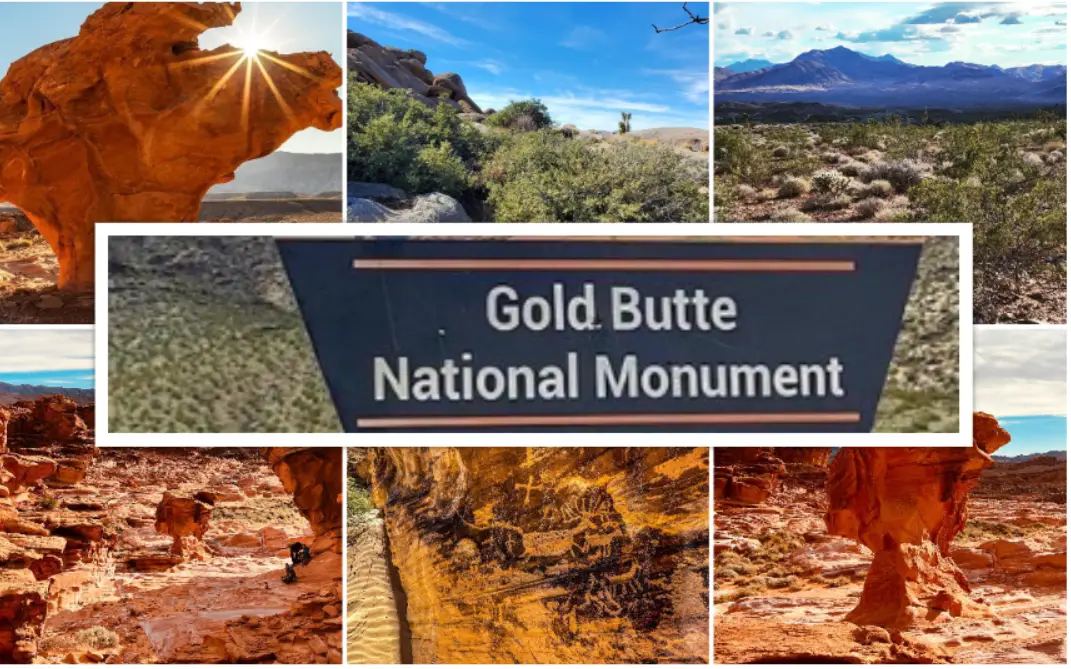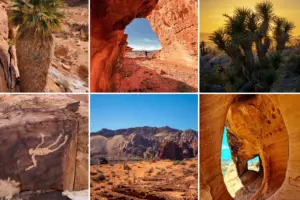Gold Butte National Monument : Interesting Facts, History & Travel Guide

- By
- Aparna Patel
- |
- 1 Apr, 2023
- |

Gold Butte National Monument is a hidden gem located in southeastern Nevada, USA. With its stunning rock formations, ancient petroglyphs, and diverse wildlife, Gold Butte is a unique and unforgettable destination.
In this blog post, we’ll explore the history and interesting facts about this remarkable place, as well as provide a comprehensive travel guide to help you plan your visit.
Whether you’re an experienced hiker, rock climber, or wildlife enthusiast, there’s something for everyone to discover in Gold Butte National Monument. So, let’s dive in and explore this amazing destination!
Table of Contents
Interesting facts about Gold Butte National Monument
- The monument covers an area of about 300,000 acres and is home to a diverse range of landscapes, including rugged mountains, canyons, and desert washes.
- Gold Butte has a rich cultural history, with evidence of human habitation dating back over 10,000 years. The area is home to numerous rock art sites, as well as historic mining and ranching structures.
- The monument is named after the prominent Gold Butte peak, which rises to an elevation of 5,580 feet above sea level.
- Gold Butte is home to a variety of rare and endangered species, including desert tortoises, bighorn sheep, and Mojave Desert sidewinders.
- The monument is popular among hikers, rock climbers, and off-road enthusiasts, who come to explore its many trails and challenging terrain.
- Gold Butte was designated as a national monument by President Barack Obama in December 2016, making it one of the most recent additions to the national monument system.
- Visitors to Gold Butte can explore a number of unique geological features, including the stunning red sandstone formations of Little Finland and the dramatic rock formations of Devil’s Throat.
- The area around Gold Butte has been used as a filming location for numerous movies and television shows, including the sci-fi classic “Star Trek: Generations” and the reality TV show “Survivor.”
- Gold Butte is located just a short drive from the famous tourist destination of Las Vegas, making it a convenient and accessible day trip for visitors to the area.
- The monument is managed by the Bureau of Land Management and is open year-round, although temperatures can be extreme during the summer months. Visitors are encouraged to bring plenty of water and sunscreen, as well as to follow Leave No Trace principles to help preserve this unique and fragile ecosystem.
Information & History of Gold Butte National Monument
The name “Gold Butte” comes from the prominent peak in the area, which is said to have been named by Mormon settlers who discovered gold in the region in the late 19th century. However, there is little evidence of significant mining activity in the area, and the name may have been a marketing ploy to attract more settlers.
In the early 20th century, the area around Gold Butte was used for grazing and ranching, and a few small mining operations were established. However, by the mid-20th century, the area had been largely abandoned, and it became a popular spot for off-road vehicle enthusiasts.
Efforts to protect the area began in the 1990s, with local conservation groups pushing for the creation of a national conservation area. In 2002, the Gold Butte National Conservation Area was established, protecting a portion of the area from development and off-road vehicle use.
In December 2016, President Barack Obama designated Gold Butte as a national monument under the Antiquities Act. The designation increased protection for the area, preserving its unique cultural, ecological, and recreational values for future generations.
Today, Gold Butte National Monument is managed by the Bureau of Land Management and is open year-round to visitors. The area is home to a diverse range of landscapes, including rugged mountains, canyons, and desert washes.
Visitors can explore the area’s rich cultural history, including numerous rock art sites, historic mining and ranching structures, and remnants of early Mormon settlements. The area is also home to a variety of rare and endangered species, making it an important ecological resource.
Read More:
- Gila Cliff Dwellings National Monument : Interesting Facts, History & Travel Guide
- Giant Sequoia National Monument : Interesting Facts, History & Travel Guide
- George Washington Carver National Monument : Interesting Facts, History & Travel Guide
- Freedom Riders National Monument : Interesting Facts, History & Travel Guide
- Fossil Butte National Monument : Interesting Facts, History & Travel Guide
- Fort Union National Monument : Interesting Facts, History & Travel Guide
- Fort Stanwix National Monument : Interesting Facts, History & Travel Guide
Travel Guide for Gold Butte National Monument
- Getting There: The nearest airport is McCarran International Airport in Las Vegas, about 90 miles southwest of the monument. From there, you can rent a car or take a guided tour to reach the monument.
- Visiting Time: Gold Butte is open year-round, but the best time to visit is in the fall and spring, when temperatures are mild. Summers can be extremely hot, with temperatures regularly exceeding 100 degrees Fahrenheit, making outdoor activities difficult. Winter temperatures can be mild during the day, but very cold at night, so be sure to bring warm clothing.
What to See and Do:
- Hiking: Gold Butte has over 130 miles of hiking trails, ranging from easy to challenging. Be sure to wear sturdy shoes and bring plenty of water.
- Rock Climbing: Gold Butte has a number of challenging rock formations that are popular among experienced climbers.
- Off-Road Vehicle Use: Gold Butte has a number of designated off-road vehicle routes, allowing visitors to explore the area’s rugged terrain.
- Rock Art Sites: Gold Butte is home to a number of ancient rock art sites, including the popular Falling Man petroglyphs.
- Little Finland: This unique geological feature, also known as “Hobgoblin’s Playground,” features stunning red sandstone formations that are a must-see for photographers and nature lovers.
- Devil’s Throat: This dramatic sinkhole is over 50 feet deep and features unique rock formations that are popular among hikers and rock climbers.
- Wildlife Watching: Gold Butte is home to a variety of rare and endangered species, including desert tortoises, bighorn sheep, and Mojave Desert sidewinders.
Where to Stay: There are no lodging facilities within the monument, but there are a number of options in the nearby towns of Mesquite and Overton. Camping is allowed in designated areas within the monument, but be sure to bring all necessary supplies and follow Leave No Trace principles.
Tips for Visiting:
- Bring plenty of water and sunscreen, and wear sturdy shoes and clothing appropriate for the weather and terrain.
- Follow Leave No Trace principles to help preserve this unique and fragile ecosystem.
- Respect cultural and historic sites, and do not disturb or remove artifacts.
- Be aware of the risk of flash flooding in canyons and washes, especially during the monsoon season (July to September).
- Stay on designated trails and roads to protect sensitive habitats and wildlife.
- Obtain any necessary permits and follow all rules and regulations for off-road vehicle use.
- Check with the Bureau of Land Management for any seasonal closures or restrictions.
More Articles:
- Fort Matanzas National Monument : Interesting Facts, History & Travel Guide
- Florissant Fossil Beds National Monument : Interesting Facts, History & Travel Guide
- Fort Frederica National Monument : Interesting Facts, History & Travel Guide
- Yosemite National Park: Interesting Facts, History & Information
- Fort Pulaski National Monument : Interesting Facts, History & Travel Guide
- Fort Ord National Monument : Interesting Facts, History & Travel Guide
FAQ about Gold Butte National Monument
Q: What is the best time to visit Gold Butte National Monument?
A: The best time to visit Gold Butte is in the fall and spring when temperatures are mild. Summers can be extremely hot, and winter nights can be very cold.
Q: What activities can I do in Gold Butte National Monument?
A: There are many activities you can do in Gold Butte, including hiking, rock climbing, off-road vehicle use, rock art site visits, wildlife watching, and more.
Q: Are there any lodging facilities in Gold Butte National Monument?
A: No, there are no lodging facilities in the monument. However, there are options in nearby towns of Mesquite and Overton.
Q: Can I camp in Gold Butte National Monument?
A: Yes, camping is allowed in designated areas within the monument, but be sure to bring all necessary supplies and follow Leave No Trace principles.
Q: Are there any entrance fees for Gold Butte National Monument?
A: No, there are no entrance fees for Gold Butte, as it is a national monument managed by the Bureau of Land Management.
Q: Can I bring my pet to Gold Butte National Monument?
A: Yes, pets are allowed in the monument, but they must be on a leash at all times and owners must clean up after them.
Q: What should I bring with me to Gold Butte National Monument?
A: You should bring plenty of water, sunscreen, sturdy shoes, appropriate clothing, and any necessary supplies for camping or hiking.
Q: Can I bring my off-road vehicle to Gold Butte National Monument?
A: Yes, off-road vehicles are allowed in designated areas, but you must obtain any necessary permits and follow all rules and regulations.
Search Posts
Latest posts
-
4 Mar, 2024
How can I do a "broad" search for flights?
-
4 Mar, 2024
Can I accidentally miss the in-flight food?
Popular posts
-
5 Mar, 2024
Why prohibit engine braking?
